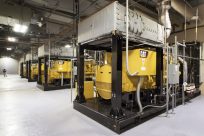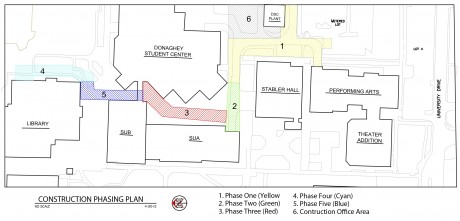UA Little Rock continues to live into the commitments of our Strategic Energy Plan while also providing effective and leading edge educational facilities for our students and staff. Below are examples of how Facilities Management is working toward energy conservation. The projects are listed from newest to oldest.
ENCON Phase 3
Building on the success of the Campus ENCON Phase 1 and 2, this project, scheduled for completion in Spring 2018, utilizes the Division of Building Authority Revolving Loan Fund (RLF) as the initial source of funding ($2M) with the avoided utility costs and some capital funds from Residence Life used to repay the 0% loan over 10 years. The project involves connecting the heating and cooling water loop piping installed in 2014 and 2015 to the existing Residence Central Energy Plant on the East side of Coleman Creek. This will help us more fully utilize our existing heat pump chiller heaters and continue to reduce our utility costs. Other portions of the project include extending district chilled water to East Dormitory and to Reynolds Business Building as well as replacement of all incandescent lighting at University Village, Donaghey Student Center, and a few other locations on campus. The capital funds contribution from Residence Life is to avoid the replacement cost of the chilled water plant in the attic of East Dorm. This project also connects to the Wingate Art and Design Center, avoiding the cost of installing and maintaining equipment serving only this building.
Main Campus Walkway Lighting Retrofit
This project provided multiple benefits to UA Little Rock. While the primary focus of this project was improving security, we also recognized energy savings. Existing lighting along the main campus walkway from Ottenheimer Library to the Fine Arts building and in the courtyard bounded by Stabler, SUA, Admin North, and CPA was replaced with new, taller poles and LED fixtures that are compliant with guidelines from the International Dark Sky Association. If you look closely, you’ll see we also added 2 fixtures and relocated others for better light distribution and uniformity. The LED fixtures not only reduce energy consumption of each fixture, they also provide light at a much different color temperature (3700K), producing much better color recognition than the previous high pressure sodium lights. The fixtures also ensure that no light is wasted by directing all of it toward the ground and none to the sky.
ENCON Phase 2
 Phase 2 encompassed the majority of the physical construction, and while some construction occurred in the heart of campus, we worked diligently to ensure everyone was notified in advance and provided with alternate pedestrian and vehicle routes.
Phase 2 encompassed the majority of the physical construction, and while some construction occurred in the heart of campus, we worked diligently to ensure everyone was notified in advance and provided with alternate pedestrian and vehicle routes.
The electrical work in Phase 2 was centered on the construction of a campus electrical generation plant on the east side of Coleman Creek and south of Lot 12 (more commonly referred to as the old Worth James property). While many buildings on campus have emergency generators for critical systems, the new generation plant will allow campus to operate normally even if we lost power from Entergy due to a storm or some other event.
The Phase 2 heating and cooling work was in 3 primary areas: expanding district heating and cooling, installing heat pump chiller heaters, and improving our building control systems. Unlike the electrical work which reduces the cost we pay for electricity, the heating and cooling projects focused on ways to reduce how much energy we consume. Connecting more buildings to the district heating and cooling system increased our ability to share equipment capacity more efficiently and thus reduced the amount of equipment consuming energy at any given time.
How we operate and control our buildings has a large impact on how much energy they consume. The expanded control system integrated the multiple systems on campus into a single, common interface, which allowed us to better monitor our space conditions, equipment, and energy consumption.
ENCON Phase 1
We built on prior energy focused projects and embarked on a $30M Campus Energy Conservation (ENCON) Project. The project was designed to reduce our campus utility costs by almost 50%. The first major step of the ENCON Project was establishing a new account with Entergy that met the requirements to activate Entergy’s Optional Interruptible Service (OIS) rider, which we achieved during the first phase of construction. The OIS rider reduced the cost UA Little Rock pays for electricity in exchange for UA Little Rock agreeing to disconnect from Entergy’s electrical grid if and when Entergy requests.
Center for Performing Arts AHU Controls Retrofit
The existing air handling units within the Center for Performing Arts had antiquated HVAC controls that were failing, and the control system did not adequately control the temperature of the space, resulting in constant operation of the equipment to try to meet space temperatures.
The controls retrofit replaced the existing controls with new digital controls, which restored proper efficient operations within the facility. Construction started in early 2012 and finished in early 2013.
DSC District Cooling Expansion
The expansion of the District Cooling System utilized the chilled water plant at the Donaghey Student Center (DSC) to provide chilled water supply to Ottenheimer Library, SUA, SUB, Stabler Hall, and the Center for Performing Arts.
Under the expansion, these chillers were removed from service with the exception for the chillers at the library, which were used in standby duty only. Once the expansion was complete, these buildings began to use the high-efficiency water-cooled DSC plant with variable flow operation. In addition, the upgraded DSC plant allows for hydronic free cooling through the use of a plate and frame heat exchanger during the cooler seasonal months.
In addition to the associated building modifications, the expansion included trenching to install below-grade supply and return piping under five construction phases as shown in the associated map. Construction started in early 2012 and finished in early 2013.
Lighting Retrofit
The lighting retrofit of the UA Little Rock campus replaced existing inefficient light fixtures across multiple buildings and installed occupancy sensors where applicable to optimize energy use.
The buildings included ETAS, Fribourgh Hall, Ross Hall, and Fine Arts. Approximately 3,700 fixtures were identified for retrofit under this project. Construction started in early 2012 and finished in early 2013.

